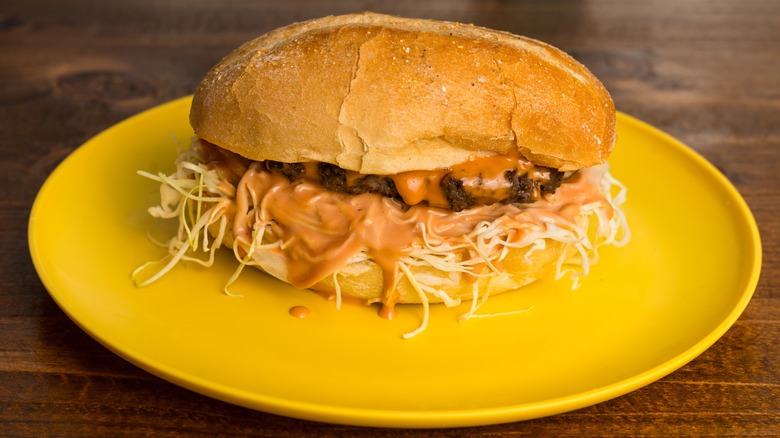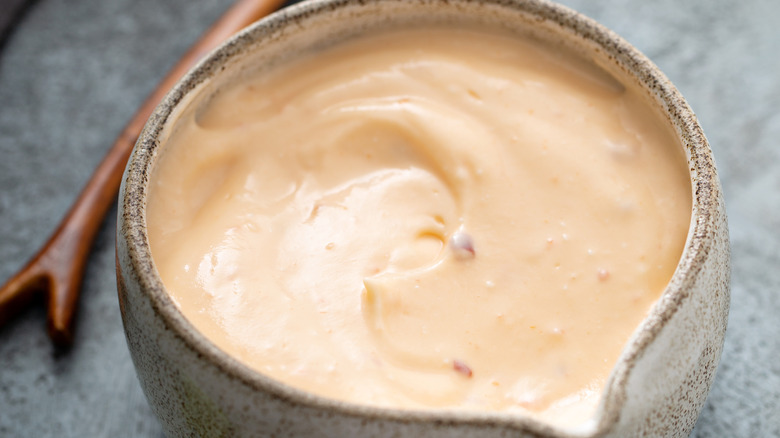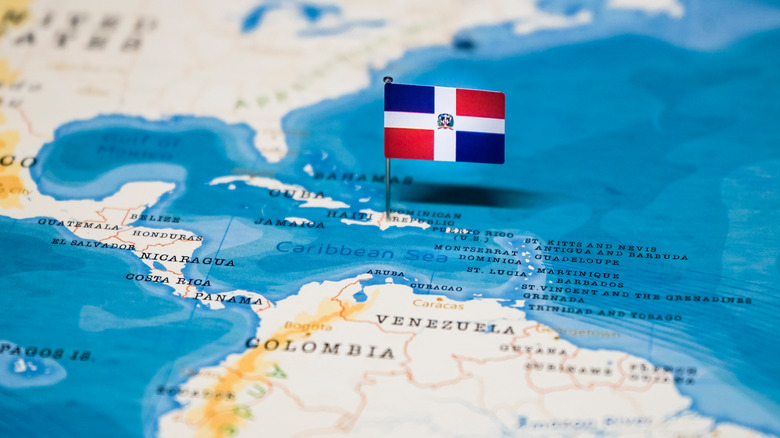The Dominican Burger That Makes Chimichurri The Star
Forget, for a moment, what you know about chimichurri: the verdant Argentinian sauce composed of fresh parsley and doused in olive oil and red wine vinegar. In Dominican cuisine, chimichurri refers to a burger. It's a beloved national dish that features a seasoned beef patty nestled between slices of pan de agua, a crusty-on-the-outside, fluffy-on-the-inside bread that's popular throughout Puerto Rico, Cuba, and the Dominican Republic. The sandwich also typically features juicy slices of tomato, red onion, and shredded cabbage in place of lettuce. The real star of the dish, though, is the generous helping of pinkish "chimi sauce" that gets slathered on top.
This mayonnaise-based condiment is creamy, tangy, and packs in some unexpected ingredients. Ask any Dominican diner about the most important part of a chimi burger, and they'll likely tell you that the chimi sauce has to be just right. Luckily, it's fairly easy to make — and comes with an interesting anecdote about how it (maybe) got its name.
Mayochup could never
As unique as chimi sauce is, you probably already have its ingredients in your fridge. A classic version calls for equal parts mayonnaise and ketchup, plus a splash of orange juice and a dash of Worcestershire sauce. (If you find yourself with leftover sauce after making chimi burgers, you're more or less legally required to dip other foods in it.)
The rest of the chimi burger process is just as simple as the sauce. The burgers often call for mixing chopped red onion, garlic, and bell pepper into ground beef, along with salt, pepper, and another dash of Worcestershire sauce. While your patties cook, you can slice up your tomatoes, spoon out some quick-pickled (or plain) red onions, and toss shredded cabbage with some chimi sauce.
If you can't get your hands on a loaf of pan de agua, you can use any relatively crusty yet tender roll bread, or even French baguette in a pinch. Just don't add cheese; it's not traditional, and this sandwich is perfect without it.
Uncertain origins
No one seems to know exactly how the chimi burger started in the Dominican Republic or why it shares a name with the Argentinian sauce to which it bears little resemblance. For now, you'll have to rely on the popular theory that an Argentinian cook named Juan Abrales brought the recipe with him when he moved to the D.R. in the 1970s. If that speculation had some truth to it, perhaps Abrales called his sandwich chimichurri in the hopes that it would forge the same prolific path as his home country's favorite condiment. In that case, he would have been pretty successful.
If you're not up to the task of making chimi burgers at home, you might be lucky enough to live near a Dominican restaurant that serves them. Rapper and culinary personality Action Bronson has recommended heading to Washington Heights, where he would order from the food trucks parked along Amsterdam Avenue. One mobile kitchen, Chimi Luisa, has parlayed its popularity into a brick-and-mortar spot nearby. Brooklynites can always head to Puerto Viejo Restaurant in Prospect Heights, a long-running spot known for its singular take on the dish. Meanwhile, for Miamians there's the Chimi El Tigre truck, where the kitchen will load your burger with fried plantains, bacon, and even a fried egg. Still, whether you leave things to the professionals or not, you might as well whip up some chimi sauce to keep in the fridge.


